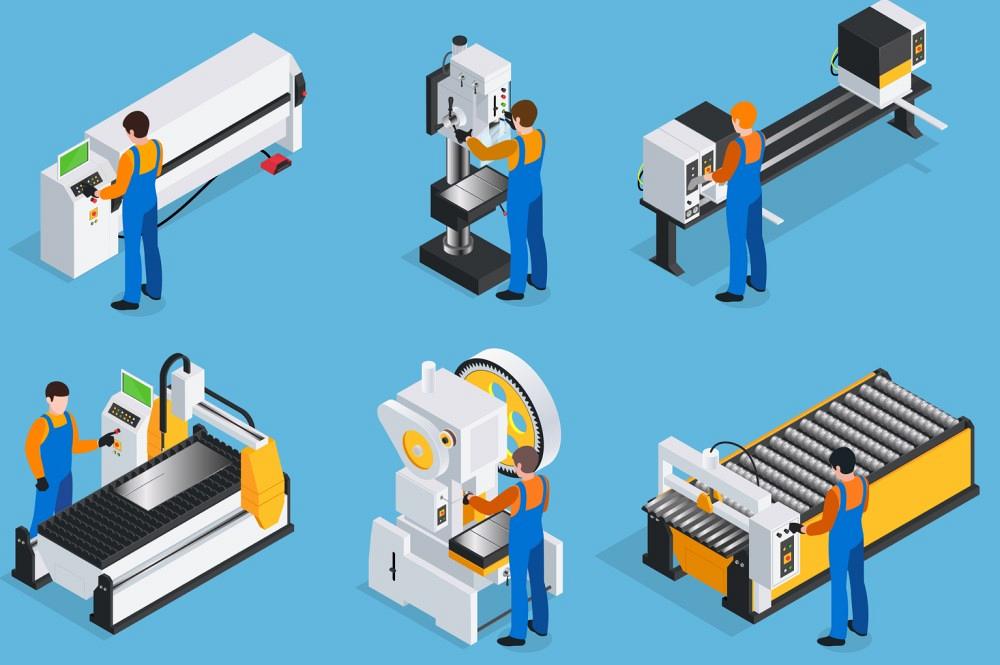General Manager
- FMA
- The Fabricator
- FABTECH
- Canadian Metalworking
Categories
- Additive Manufacturing
- Aluminum Welding
- Arc Welding
- Assembly and Joining
- Automation and Robotics
- Bending and Forming
- Consumables
- Cutting and Weld Prep
- Electric Vehicles
- En Español
- Finishing
- Hydroforming
- Laser Cutting
- Laser Welding
- Machining
- Manufacturing Software
- Materials Handling
- Metals/Materials
- Oxyfuel Cutting
- Plasma Cutting
- Power Tools
- Punching and Other Holemaking
- Roll Forming
- Safety
- Sawing
- Shearing
- Shop Management
- Testing and Measuring
- Tube and Pipe Fabrication
- Tube and Pipe Production
- Waterjet Cutting
Industry Directory
Webcasts
Podcasts
FAB 40
Advertise
Subscribe
Account Login
Search
Why cross-training is so critical in custom metal manufacturing
How it’s foundational to the success of one custom fab shop in Mississippi
- By Steven Guisgond
- July 21, 2020
- Article
- Shop Management

A typical custom metal fabricator must manage highly variable demand. That’s why cross-training continues to play a central role. Getty Images
Custom metal fabrication is a skill-intensive job. Training and education are critical to career success, not only at the beginning of any job but throughout a lifetime. Continuous training enhances the employee’s capabilities and level of production while creating a safer environment for everyone in the shop.
It’s complex work. No two projects or procedures look exactly the same. Demand levels change. A press brake operator might have hundreds of parts to bend one day, then no parts at all the next. The schedule drives everything and employees must adapt, which is why cross-training has become so critical.
That said, training in custom fabrication isn’t straightforward. Experienced craftspeople train younger workers and carry on the mentor-protégé relationship. As workers pass through the doors of custom shops and this mentorship program continues, the wealth of knowledge and experience grows, passing from one generation to the next.
A rookie shadowing a press brake guru eventually turns into a guru himself, who in turn can train another rookie—and it’s all focused on a single manufacturing step: plate and sheet metal bending, in this case. At the same time, many employees, especially younger ones, might get bored operating one machine day after day. Moreover, an ever-changing schedule forces workers to adapt, problem-solve, perform different tasks, and move to free a constraint.
Many modern shops need cross-trained workers, but they still need process-specific expertise. How does an operation build such process-specific expertise and cross-training into its culture? It’s about finding a balance, and in recent years Meridian, Miss.-based Ci Metal Fabrication has done just that.
A Diverse Operation
At first glance Ci Metal looks like the quintessential plate fabrication job shop. Work flows from the plasma table and band saws to bending at the press brake, then on to fitting, welding, finishing, and final assembly. The 17 employees in the shop aren’t mere button-pushers. They process highly customized, complex work that ranges from small replacement parts to massive hoppers and other boiler components that can span the width of the shop floor.
In this environment a lack of cross-training would create constraints. If the shop had only a limited number of dedicated welders, they may struggle to get the project done on time. But when cross-trained employees can move around to ensure the welding job is completed on time, the story changes. When it comes to meeting production goals, cross-training can make the difference between failure and success.
Focus on Safety
Employees’ first days on the job set the tone: Productivity is important, but employee safety reigns. All new employees at Ci Metal must attend a full-day certification of the company’s Standard Orientation Program, or STOP, which details company policies and safe work procedures.
They continue to receive updated safety training throughout their tenure with the company. Empowered to stop unsafe work conditions, employees understand the need to complete each task safely while ensuring co-workers do the same.
Expectations on Cross-Training
When people apply for a job at Ci Metal, they know during the interview that the job will involve extensive cross-training. For example, if they’re hired on as a fitter, they’re told that the company will invest in training that goes beyond the traditional “fitter” job description. Being a fitter—reading blueprints, performing layout, tacking, and weld prep—will be their main job. But the company also will invest in their training to become a certified welder. Likewise, when welders are hired, they’re told that they’ll also be fitters. If they don’t already know how to read blueprints and perform layout, they’ll be trained to do so.
The same applies when Ci Metal hires general laborers. They’ll start out as helpers and material handlers, but they know that’s only the beginning. They will learn how to run the shear, plasma table, and press brake. They’ll learn how to become a fitter, and they’ll eventually know how to perform basic, non-code-level welding.
Mentor-Protégé Relationship
Each area in the shop has a lead. That lead also serves as the process-specific mentor, be it in fitting, welding, or specific machine operation. These individuals have achieved the highest level of proficiency and certification in a certain area, a level the shop designates as a “Class A” position—like Class A fitter or Class A machine operator. (Welders have similar designations, but they’re also certified to AWS D1.1 to perform code-level work.) The leads in each area serve as the mentor in the mentor-protégé relationship.
The shop relies on these talented mentors—all of whom average more than 30 years of industry experience each in presswork, forming, welding, cutting, and shearing—to usher in the next generation of metalworkers. These veterans are invaluable for their ability to read, translate, and understand a customer’s design and blueprints for a project. They use these skills to develop the best route for production and plan how to navigate possible problems.
The trainer breaks down the steps so the new employee will understand what each process is and why it is necessary. The less experienced craftsperson must understand the complexities of blueprints, project drawings, different metals, materials, and other elements that go into a job.
Then come the data sheets, safety protocols, and product qualities such as tensile strength, hardness, as well as resistances and elemental traits. Rookies learn which metal to use, the bending technique, and the correct procedures for each process step. Over time these techniques and decisions become second nature.
Their mentors are process-specific experts, but even they are still cross-trained. The company’s best welder can also fit and operate machines. Yes, he’s a highly qualified welder, but that talent doesn’t add much value if a constraint persists elsewhere in the shop.
Cross-Training Based on Demand
Because Ci Metal is a job shop, its schedule drives everything, and this includes who is cross-trained on what and when. If a job requires shearing, a newly hired general laborer might shadow the area lead to learn the basics of machine operation. The next week, the schedule might call for extensive plasma cutting. The area lead observes the new hire and, if he’s a quick learner and shows mechanical aptitude, will introduce him to the burn table. And the learning continues from there.
Over a period of several months, that new hire becomes a jack of all trades, but with the goal of mastering at least one. He might take to fitting and climb the ranks from Class C, to B, then finally A. At that point he becomes a mentor in the fitting area—but again, that still doesn’t mean he no longer spends time operating a machine or even simply moving material. The goal is to keep jobs on the move.
The Cultural Impact
What incentivizes such cross-training? The pay grade plays a part, of course, but it’s not the whole story. The right shop culture provides the foundation, and for the most part, a top-down, my-way-or-the-highway approach just doesn’t suit.
Process-specific training does have a top-down element to it, especially when it comes to the fundamentals. If rookies didn’t follow fundamental procedures that their mentors taught them, the shop would lack standard best practices and quality would suffer. But in general, Ci Metal takes a ground-up approach where even the greenest of greenhorns are given an opportunity to present their ideas.
The company’s pre-job kickoff meetings help illustrate this concept. Small jobs involving replacement parts and other minor work usually go straight to the shop floor. But if the shop receives an order for, say, a large custom boiler room hopper—with a lead time of months instead of weeks or days—then project management comes into play, and this starts with a kickoff meeting.
Managers select a mentor—also called lead fabricator or project manager—as well as a project team. The team’s size and breadth of expertise depend on the project, but every team shares one common trait: They include people from all levels of the organization, from the most experienced to the newest employees.
To start, the estimator, shop superintendent, and project leader go over the estimate and what assumptions were made, including the method and hours allotted to certain tasks. The meetings typically entail everything from ordering materials and establishing cutting and bending procedures to identifying proper sequences for tasks.
After the office meeting, the job moves immediately to an open forum with the entire project team. Leaders ask, “What do you think? Is there a better way to do this?” Everyone has a chance to respond, including new employees on the first rung of their career ladder.
This promotes the mentorship mentality, because these discussions can help new employees learn why certain ideas will or won’t work. At the same time, the approach is collaborative, not a top-down directive. The best idea wins, no matter who suggests it.
Quite often, in fact, the company’s newest employees provide fresh perspective. On a recent project, the team debated how best to fabricate a large workpiece. Seeing the project’s complexity, most thought it would require a week or more in the fitting area. One of the company’s youngest employees—a rookie Class C fitter—realized that certain structural elements of the workpiece stood at different elevations. He discovered that, when oriented a specific way, the piece could be fitted within just four hours.
Avoiding Silos
Consider a shop where a welder only welds, a painter only paints, and a fitter only fits. This “siloed” approach is common, but it also has its challenges, especially in a job shop that must adapt to constantly changing demand. It also can tie a person’s value solely to their process-specific expertise, which creates cross-training hurdles of its own. Veterans might think they’re being asked to train their replacement.
That’s why effective cross-training sometimes requires a complete organizational and cultural transformation, one that encourages employees to learn various tasks and procedures across the shop. The ultimate goal is to make each team member a more flexible piece of the puzzle. Each knows the various components that go into an entire project and, therefore, becomes more adept at problem-solving. Together they comprise an engaged workforce that leads to more success by delivering high productivity and low accident rates.
Cross-training benefits not only the company, but employees themselves, who become more experienced and, thus, more valuable. They aren’t burdened with button-pushing monotony but instead face new challenges every day. A shop culture that encourages this tends to attract better talent, which helps the business grow—and the virtuous cycle continues.
About the Author
subscribe now

The Fabricator is North America's leading magazine for the metal forming and fabricating industry. The magazine delivers the news, technical articles, and case histories that enable fabricators to do their jobs more efficiently. The Fabricator has served the industry since 1970.
start your free subscription- Stay connected from anywhere

Easily access valuable industry resources now with full access to the digital edition of The Fabricator.

Easily access valuable industry resources now with full access to the digital edition of The Welder.

Easily access valuable industry resources now with full access to the digital edition of The Tube and Pipe Journal.
- Podcasting
- Podcast:
- The Fabricator Podcast
- Published:
- 04/16/2024
- Running Time:
- 63:29
In this episode of The Fabricator Podcast, Caleb Chamberlain, co-founder and CEO of OSH Cut, discusses his company’s...
- Industry Events
16th Annual Safety Conference
- April 30 - May 1, 2024
- Elgin,
Pipe and Tube Conference
- May 21 - 22, 2024
- Omaha, NE
World-Class Roll Forming Workshop
- June 5 - 6, 2024
- Louisville, KY
Advanced Laser Application Workshop
- June 25 - 27, 2024
- Novi, MI
































